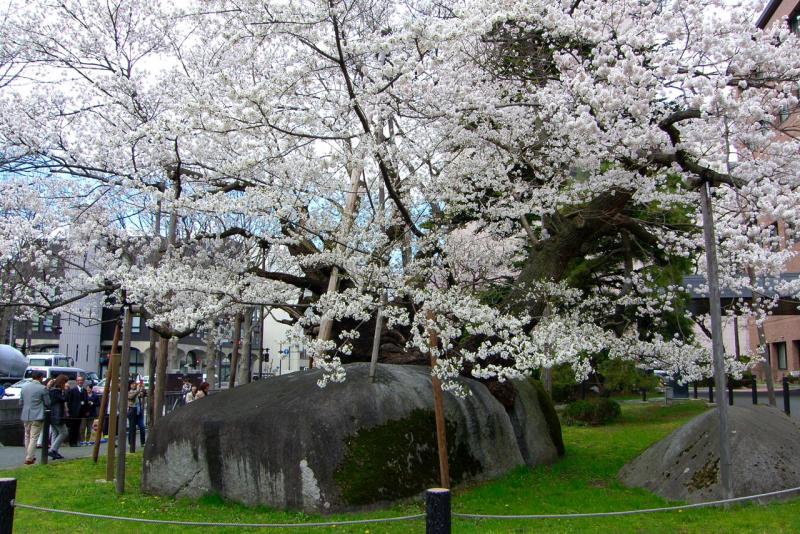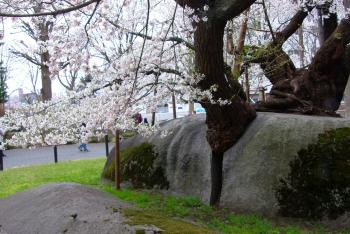Lost and found in Japan
This item appears on page 15 of the April 2018 issue.
My husband, Clyde, and I made a day trip to Morioka, Japan, from Sendai on April 21, 2017. It was a last-minute decision near the end of our 6-week pursuit of sakura (cherry blossoms) for that year. We always have many day trips researched for each city we visit, and we decide which ones to make depending on the condition of the blossoms and the weather when we get there.
We used our Japan Rail (JR) Passes to get our tickets for the trip early that morning. It was very close to departure time, and the only two seats available were 10 rows apart but in the same car.
Once the train left the station, we relocated and sat in a pair of vacant seats. We were now in front of a row with a jolly group of five men, who acknowledged and approved of our train savvy. As we got off the train in Morioka, the men all high-fived us and wished us well.
Upon our arrival at Morioka, we bought one-day bus passes (each ¥300, about $2.85) and headed for the Morioka courthouse to see Ishiwarizakura, the ancient and much beloved rock-splitting cherry tree growing out of a crack in a granite boulder.
As we photographed this blossoming marvel, the sun went in and it started to mizzle. I suddenly realized I had left my shawl on the train! When I had turned to wave good-bye to the group of five, I didn’t see my shawl hanging on the coat hook next to my seat.
I had bargained hard for that shawl in Almora, India, paying about $1 for it. I have since taken this color-perfect pink-and-burgundy shawl on many, many sakura trips. I own about 100 shawls, purchased over the course of 10 trips to India, so the loss was not tragic, but the shawl was a favorite.
Nothing could be done about the shawl, so we continued with our plan to visit the Morioka Castle Ruins Park, where many of the cherry trees were in the early stages of bloom, further behind the earlier-blossoming Ishiwarizakura. Among the throngs of hanami (cherry-blossom-viewing) parties, a student orchestra was giving a mini-concert.
After we had our fill of photographing the hanami crowds, we walked the riverside path along the banks of the Nakatsugawa, with its Meiji-era buildings and just-opening sakura. We visited the landmark 1911 red-brick Bank of Iwate, which allows free entry for much of the building and charges an entry fee for other areas. (We only visited the free section.)
We strolled past the wooden Konyacho Fire Watchtower and took time for a quick lunch at a Doutor Coffee shop.
It was drizzling on and off, and the day had become quite gray and cold, so we decided to return to Sendai. Without much hope for my shawl, we stopped at the Morioka Tourist Information Center, where we had begun our day getting maps and information about what was in bloom and what wasn’t. I hoped to learn from the TIC agent where to find the JR lost-and-found office.
The agent wrote down my tale of woe and handed the information to the man at the next table, who, much to our amazement, was a JR agent. He picked up his phone, called somewhere and talked and talked. He then reported to the TIC woman, who told us that my shawl was in Hakodate, Hokkaido, the northern terminus of our train.
He said that JR would send the shawl to our hotel if we agreed to pay the shipping. We were leaving Sendai the next day for Ueno, Tokyo, so we asked to have the package sent there. The agent picked up another phone and called our hotel in Ueno to be sure they would accept a COD package for which we would reimburse them. They agreed.
The package was scheduled to arrive the day before we were to depart for home. Japan being Japan, I had some hope this all would actually work out.
The next morning, before checking out of Hotel JAL City Sendai (1-2-12 Kakyoin, Aoba-ku, Sendai-shi, Miyagi 980-0013, Japan), I looked under the bed, as I always do before departing, to be sure we hadn’t left anything. I found a wallet! It contained ¥90,000 (about $850) and several credit cards.
I took it to the hotel desk, where the receptionist looked most puzzled; she spoke no English, so I couldn’t explain that I had found the wallet and it wasn’t mine. I wrote out an explanation and hoped the English-speaking concierge would translate it when she came on duty.
We later received an email from the concierge thanking us for the wallet and saying she had sent it to the owner.
My scarf arrived at our Ueno hotel on the day JR said it would, one day before our departure for home. We paid the equivalent of $10 for the shipping, and it was worth every penny.
We’ve always known that the Japanese are honest to the core. We’ve lost coins on hotel room floors and found them placed carefully on the desk by housekeeping. We’ve had people come chasing after us to return a ¥10 coin (about 9 cents) that we’ve dropped.
We don’t understand how a wallet went unnoticed by housekeeping, but we are happy that we were able to help get it back to its owner.
And, for good measure, one more find — in November 2017, on our annual foliage trip to Japan, Clyde found ¥5,000 on a sidewalk in Nikkō. We had no idea to whom we could return the money, so we put it in the donation box at our favorite temple.
JANE B. HOLT
Hinesburg, VT


